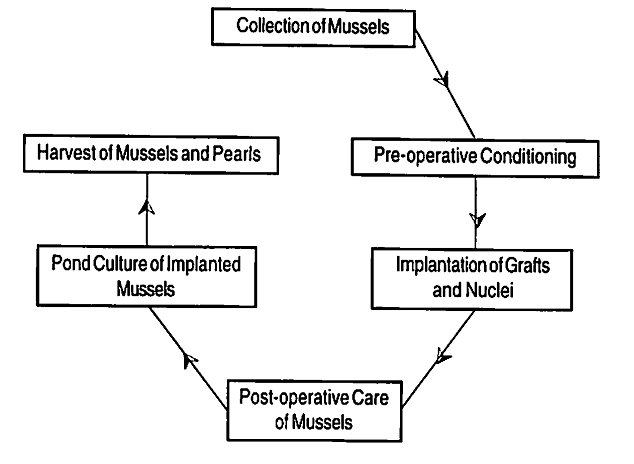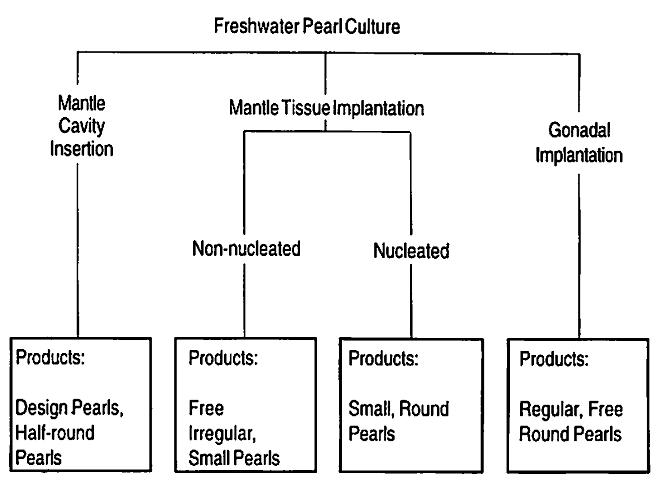|
Farming practice of the freshwater pearl culture operation involves six major steps
sequentially viz., collection of mussels, pre-operative conditioning,
surgery, post-operative care, pond culture and harvesting of pearls, for easier understanding, its has been diagrammatically shown at the end of the page: 
Various Factors that decides
the Price of Fresh Water Pearl
The grading of fresh water pearls is more
variable than that of saltwater pearls. Nevertheless, Freshwater pearls are
generally valued according to the
following criteria:
LUSTRE:
The higher and more even the lustre, the greater the value. Low-quality
freshwater pearls may seem lustrous to a lay person because often part of their
surface is very shiny. However, if some areas of the pearls look milky, chalky
and dull, they are considered to have a low lustre. In high quality fresh water pearls there is an evenly
distributed lustre and a high contrast between the light and dark areas of the
pearls.
When judging freshwater pearls for lustre, examine them on a white background
and be sure to roll them so you can see their entire surface area. If
possible,
compare strands of different qualities. It's important that your eye become
sensitive to lustre variations because lustre is one of the most
important
determinants of value in pearls of all types.
SMOOTHNESS:
The smoother the pearl, the more valuable it is. Even though
bumpy, wrinkled surfaces can lower the value of fresh
water pearls the bumps and
wrinkles are not considered flaws.
SIZE/WEIGHT:
Freshwater pearl size is not as important of a price factor as is lustre and
surface quality. Freshwater pearl prices are generally quoted by weight or by
the strand. The gram is probably the most common unit of weight used at the
retail level, but some dealers quote prices according to carat weight. The
size
of round fresh water pearls may be
expressed by their diameter, measured in millimetres.
SHAPE:
Usually the more round a pearl is, the greater its value. Good symmetry, too,
can make a pearl more valuable. In addition, thin shapes tend to sell for
less
than fatter-looking shapes. Fresh water
pearls are baroque shaped. This is the lowest priced shape, all other
factors being equal, Large
high-quality, baroque shapes can command high prices
and make distinctive jewellery piece. Since 1992, a lot of semi-round
(off-round) and oval
freshwater pearls have become available, of late designed
pearls are also in demand.
SURFACE QUALITY:
Obvious blemishes such as discolorations, pits and cavities can
decrease the value of a pearl considerably, especially if the pearl is
otherwise of high
quality. Normally, though, flaws in fresh water pearls aren't very noticeable,
due to their baroque shapes. Consequently, surface imperfections tend to
have
less of an effect on the value of freshwater pearls than on those of saltwater
pearls.
COLOR:
Fresh water pearls come in a wide variety of body colours-white,
pink, orange, yellow, lavender, gray Some pearls are even bi-coloured. The body
colour does not affect the price of freshwater pearls as much as it does that
of saltwater pearls. The presence of overtone colours such as pink and
silver
makes them more valuable. Natural color pearls are more highly valued than
those which are dyed and/or irradiated.
NACRE THICKNESS
Freshwater pearls
typically cost less than saltwater pearls. Low prices, though, don't
necessarily mean low quality. Therefore don't just judge pearls by their price
tag. Consider their lustre, their colour, their uniqueness. If you do, you'll discover
that freshwater pearls offer great variety, beauty and value.
Tests, a
Layperson Can Do To Tell The Difference between an Natural and Cultured Pearl
Drill Hole Test: Look
inside the drill hole with a 10-power magnifier. If you can see a dark dividing
line separating the nacre from a pearl bead nucleus, the pearl is cultured.
This dark line is conchiolin, the material which binds the nacre to the bead.
Natural pearls may show a series of growth lines, which get more yellow or
brown towards the center of the pearl. A black deposit at the center of a white
pearl can be a sure sign the pearl is natural.
Also note the size of the drill hole. The drill holes of natural pearls are
rarely larger than .04 mm (.016 inch). Those of cultured pearls tend to measure
.06 mm (.024 inch). Natural pearls are partly valued by weight, so the holes
are made as small as possible to minimize weight loss.
Shape Test: Do the pearls look
perfectly round? If so, then it's likely they're cultured. Natural pearls tend
to have at least slightly irregular shapes, even though a few are round. This
test is only an indication. It is not proof.
Blink Test: Hold the strand
near the front edge of a strong desk lamp. The light should shine through the
pearls but not in your eyes. Rotate the
strand. If the pearls blink from light
to dark as they are turned, this indicates they are cultured and have a thin
coating of nacre (imitation pearls with
mother-of-pearl shell-bead centers may
also blink). The dark areas result when there are dense mother-of-pearl layers
on the shell bead which block
the light. Cultured pearls with thin nacre may
show only one view when rotated. In other words, they don't necessarily blink.
Stripe Test: As you rotate the
pearls with strong light shining through them, look for curved lines and
stripes. These are the growth layers of the shell
beads. If they are visible,
the nacre is very thin and the pearls are cultured. Not all shell bead nuclei
show stripes, though. This can be seen in figure 14.7. Keep in mind that
imitation pearls with shell-bead centers can also display this banded effect.
Natural pearls, however, will not look striped.
Color Test: Examine the colour.
Cultured pearls often have a faint greenish tint, unlike natural pearls. Some
dealers find that the colour of natura l pearls has a greater potential for
brightness than that of cultured pearls. Colour can only suggest a pearl might
be cultured. It is not a proof.
|


